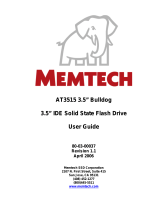
Step 1: Installation Checklist
To install the Deskstar drive you may need the following depending on your computer:
1) __ The installation kit that came with your Deskstar drive containing 4 mounting screws,
IDE cable, Ontrack® Disk Manager and any related publications. Save the box the
drive came in.
2) __ The documentation that came with your computer or storage enclosure.
3) __ A small, flat-blade screwdriver.
4) __ An IDE controller, which is either built in or an adapter inside your computer. Have
documentation readily available for your IDE controller also.
5) __ Mounting brackets, if required for your computer. Contact your place of purchase if you
are unsure if mounting brackets are required.
6) __ A bootable DOS diskette. (If one is not available to you, see instructions for making a
bootable DOS diskette in the appendix.) The Ontrack® diskette is bootable.
7).__ If you are replacing an older internal drive with the new Deskstar drive and want to copy all of the
files from the older drive to your new one, you may need additional software. (See the section on
Drive Copy on page 25 for information.)
Continue installation with the following procedures:
1) __ Backup your existing drive to avoid any loss of data during installation.(see Backup & Restore on
page 24) After completing backup, shut down as normal.
2) __ Unplug your system from the electrical outlet.
3) __ Establish a common voltage between you and the hard drive. Touch an unpainted metal
surface on the outside of your system with your bare hands and the hard drive in it’s
anti-static bag simultaneously. Avoid excessive movement until the drive has been mounted.
4) __ DO NOT LOW-LEVEL FORMAT YOUR IDE DRIVE! IDE drives are low-level formatted by the
manufacturer and reformatting may cause permanent damage to yourdrive and your system.
(See Utilities on page 25)
5) __ Record the following information:
Drive Model ________________ Date of Purchase_________________
Drive P/N __________________ Place of Purchase_________________
Serial # ____________________
If you currently have a hard drive in your system you may want to record the CMOS settings. This
information is in your BIOS setup. You can enter your BIOS setup by pressing the key sequence for your
system while booting. (See BIOS on page 15)
Cylinders _______________________ Sectors/Track_____________________
Heads __________________________ Landing Zone _____________________
Write Pre Comp (if you have this category) __________________





















